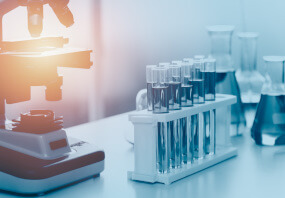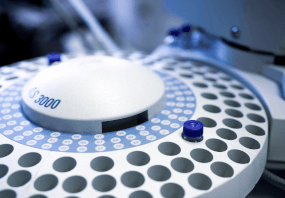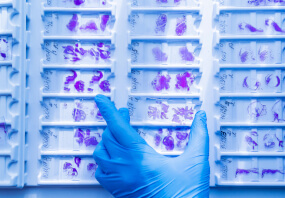Pseudomonas aeruginosa grows well on all normal laboratory media but specific isolation of the organism, from environmental sites or from human, animal or plant sources, is best carried out on a medium, which contains a selective agent and also constituents to enhance pigment production. Most selective media depend upon the intrinsic resistance of the species to various antibacterial agents. Cetrimide inhibits the growth of many microorganisms whilst allowing Pseudomonas aeruginosa to develop typical colonies. Cetrimide is a quaternary ammonium salt, which acts as a cationic detergent that reduces surface tension in the point of contact and has precipitant, complexing and denaturing effects on bacterial membrane proteins. It exhibits inhibitory actions on a wide variety of microorganisms including Pseudomonas species other than Pseudomonas aeruginosa . King et al developed Medium A for the enhancement of pyocyanin production by Pseudomonas (1). Cetrimide Agar developed by Lowburry (2) is a modification of Tech Agar (Medium A) with addition of 0.1% cetrimide for selective isolation of P.aeruginosa . Later, due to the availability of the highly purified cetrimide, its concentration in the medium was decreased (3). The incubation was carried out at 37°C for a period of 18-24 hours (4). P.aeruginosa can be identified due to their characteristic production of pyocyanin, a blue, water-soluble, non-fluorescent phenazine pigment coupled with their colonial morphology and the characteristic grape-like odor of aminoacetophenone (5). P.aeruginosa is the only species of Pseudomonas or gram-negative rod known to excrete pyocyanin. These media are therefore, important in the identification of P.aeruginosa . These media are used for the examination of cosmetics (6) and clinical specimens (5, 7) for the presence of P.aeruginosa , as well as for evaluating the efficacy of disinfectants against this organism (8). Pancreatic digest of gelatin provide necessary nutrients for P.aeruginosa . Sodium chloride maintains osmotic equilibrium in the medium. Magnesium chloride and potassium sulfate stimulates pyocyanin production. (9). For the isolation of P.aeruginosa , plates of Cetrimide Agar should be inoculated from non-selective medium such as Brain Heart Infusion Broth (M210) or Soyabean Casein Digest Medium (M011). If the count is high, the test sample can be directly inoculated onto Cetrimide Agar. P.aeruginosa colonies may appear pigmented blue, blue-green or non-pigmented. Colonies exhibiting fluorescence at 250nm and a blue green pigmentation are considered as presumptive positive. P.aeruginosa may lose its fluorescence under UV if the cultures are left at room temperature for a short time. Fluorescence reappears after the plates are re-incubated (4). Type of peptone used in the base may also affect pigment production (4, 10). Certain strains of P.aeruginosa may not produce pyocyanin. Other species of Pseudomonas do not produce pyocyanin but fluoresce under UV light. Most non- Pseudomonas species are inhibited on Cetrimide Agar, and some species of Pseudomonas may also be inhibited. Some non-fermenters and some aerobic spore formers may exhibit a water-soluble tan to brown pigmentation on this medium. Serratia may exhibit pink pigmentation (3). Biochemical tests and serological procedures should be performed to confirm the findings. Storage and Shelf-life: Store below 30°C in tightly closed container and the prepared medium at 2-8°C. Use before expiry date on the label. Pseudomonas aeruginosa grows well on all normal laboratory media but specific isolation of the organism, from environmental sites or from human, animal or plant sources, is best carried out on a medium, which contains a selective agent and also constituents to enhance pigment production. Most selective media depend upon the intrinsic resistance of the species to various antibacterial agents. Cetrimide inhibits the growth of many microorganisms whilst allowing Pseudomonas aeruginosa to develop typical colonies. Cetrimide is a quaternary ammonium salt, which acts as a cationic detergent that reduces surface tension in the point of contact and has precipitant, complexing and denaturing effects on bacterial membrane proteins. It exhibits inhibitory actions on a wide variety of microorganisms including Pseudomonas species other than Pseudomonas aeruginosa . King et al developed Medium A for the enhancement of pyocyanin production by Pseudomonas (1). Cetrimide Agar developed by Lowburry (2) is a modification of Tech Agar (Medium A) with addition of 0.1% cetrimide for selective isolation of P.aeruginosa . Later, due to the availability of the highly purified cetrimide, its concentration in the medium was decreased (3). The incubation was carried out at 37°C for a period of 18-24 hours (4). P.aeruginosa can be identified due to their characteristic production of pyocyanin, a blue, water-soluble, non-fluorescent phenazine pigment coupled with their colonial morphology and the characteristic grape-like odor of aminoacetophenone (5). P.aeruginosa is the only species of Pseudomonas or gram-negative rod known to excrete pyocyanin. These media are therefore, important in the identification of P.aeruginosa . These media are used for the examination of cosmetics (6) and clinical specimens (5, 7) for the presence of P.aeruginosa , as well as for evaluating the efficacy of disinfectants against this organism (8). Pancreatic digest of gelatin provide necessary nutrients for P.aeruginosa . Sodium chloride maintains osmotic equilibrium in the medium. Magnesium chloride and potassium sulfate stimulates pyocyanin production. (9). For the isolation of P.aeruginosa , plates of Cetrimide Agar should be inoculated from non-selective medium such as Brain Heart Infusion Broth (M210) or Soyabean Casein Digest Medium (M011). If the count is high, the test sample can be directly inoculated onto Cetrimide Agar. P.aeruginosa colonies may appear pigmented blue, blue-green or non-pigmented. Colonies exhibiting fluorescence at 250nm and a blue green pigmentation are considered as presumptive positive. P.aeruginosa may lose its fluorescence under UV if the cultures are left at room temperature for a short time. Fluorescence reappears after the plates are re-incubated (4). Type of peptone used in the base may also affect pigment production (4, 10). Certain strains of P.aeruginosa may not produce pyocyanin. Other species of Pseudomonas do not produce pyocyanin but fluoresce under UV light. Most non- Pseudomonas species are inhibited on Cetrimide Agar, and some species of Pseudomonas may also be inhibited. Some non-fermenters and some aerobic spore formers may exhibit a water-soluble tan to brown pigmentation on this medium. Serratia may exhibit pink pigmentation (3). Biochemical tests and serological procedures should be performed to confirm the findings. Storage and Shelf-life: Store below 30°C in tightly closed container and the prepared medium at 2-8°C. Use before expiry date on the label. References: 1. King, Ward and Raney, 1954, J. Lab. Clin. Med., 44:301. 2. Lowbury, 1951, J. Clin. Pathol., 4:66. 3. Lowbury and Collins, 1955, J. Clin. Pathol., 8:47 4. Brown and Lowbury, 1965, J. Clin. Pathol., 18:752. 5. Murray P. R., Baron J. H., Pfaller M. A., Jorgensen J. H. and YolkenR. H., (Ed.), 2003, Manual of Clinical Microbiology,8th Ed., American Society for Microbiology, Washington, D.C. 6. USFDA Bacteriological Analytical Manual, 2005, 18th Ed., AOAC, Washington, DC. 7. Forbes B. A., Sahm A. S. and Weissfeld D. F., Bailey & Scotts Diagnostic Microbiology, 10th Ed., 1998, Mosby, Inc., St. Louis, Mo. 8. Williams, (Ed.), 2005, Official Methods of Analysis of the Association of Official Analytical Chemists, 19th Ed., AOAC, Washington, D.C. 9. MacFaddi
- UPC:
- 51282205
- Condition:
- New
- Availability:
- 3 Days
- Weight:
- 1.00 Ounces
- HazmatClass:
- No
- WeightUOM:
- LB
- MPN:
- M024-500G















